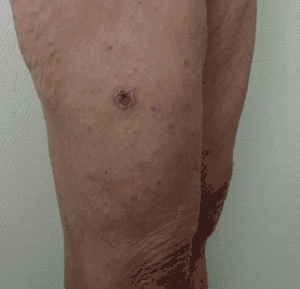Boutonneuse fever
| Boutonneuse fever | |
|---|---|
 | |
| Typical eschar and spots on the leg of a patient with Boutonneuse fever[1] | |
| Specialty | Infectious disease |
Boutonneuse fever (also called Mediterranean spotted fever, fièvre boutonneuse, Kenya tick typhus, Indian tick typhus, Marseilles fever, or African tick-bite fever, or Astrakhan Fever) is a fever as a result of a rickettsial infection caused by the bacterium Rickettsia conorii and transmitted by the dog tick Rhipicephalus sanguineus. Boutonneuse fever can be seen in many places around the world, although it is endemic in countries surrounding the Mediterranean Sea. This disease was first described in Tunisia in 1910 by Conor and Bruch and was named boutonneuse (French for "spotty") due to its papular skin rash characteristics.[1][2]
Presentation
After an incubation period around seven days, the disease manifests abruptly with chills, high fevers, muscular and articular pains, severe headache, and photophobia. The location of the bite forms a black ulcerous crust (tache noire). Around the fourth day of the illness, a widespread rash appears, first macular and then maculopapular and sometimes petechial.
Diagnosis
The diagnosis is made with serologic methods, either the classic Weil-Felix test (agglutination of Proteus OX strains ), ELISA, or immunofluorescence assays in the bioptic material of the primary lesion.
Treatment
The illness can be treated with tetracyclines (doxycycline is the preferred treatment), chloramphenicol, macrolides or fluoroquinolones.
See also
References
- 1 2 Rovery C, Brouqui P, Raoult D (2008). "Questions on Mediterranean Spotted Fever a Century after Its Discovery". Emerg Infect Dis. 14 (9): 1360–1367. doi:10.3201/eid1409.071133. PMC 2603122. PMID 18760001.
- ↑ Conor, A; A Bruch (1910). "Une fièvre éruptive observée en Tunisie". Bull Soc Pathol Exot Filial. 8: 492–496.
External links
| Classification |
|---|